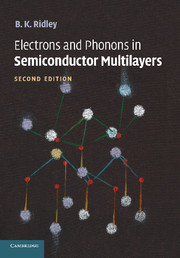Book contents
- Frontmatter
- Contents
- Preface
- Introduction
- 1 Simple Models of the Electron–Phonon Interaction
- 2 Quantum Confinement of Carriers
- 3 Quasi-Continuum Theory of Lattice Vibrations
- 4 Bulk Vibrational Modes in an Isotropic Continuum
- 5 Optical Modes in a Quantum Well
- 6 Superlattice Modes
- 7 Optical Modes in Various Structures
- 8 Electron–Optical Phonon Interaction in a Quantum Well
- 9 Other Scattering Mechanisms
- 10 Quantum Screening
- 11 The Electron Distribution Function
- 12 Spin Relaxation
- 13 Electrons and Phonons in the Wurtzite Lattice
- 14 Nitride Heterostructures
- 15 Terahertz Sources
- Appendix 1 The Polar-Optical Momentum-Relaxation Time in a 2D Degenerate Gas
- Appendix 2 Electron/Polar Optical Phonon Scattering Rates in a Spherical Cosine Band
- References
- Index
Preface
Published online by Cambridge University Press: 05 September 2009
- Frontmatter
- Contents
- Preface
- Introduction
- 1 Simple Models of the Electron–Phonon Interaction
- 2 Quantum Confinement of Carriers
- 3 Quasi-Continuum Theory of Lattice Vibrations
- 4 Bulk Vibrational Modes in an Isotropic Continuum
- 5 Optical Modes in a Quantum Well
- 6 Superlattice Modes
- 7 Optical Modes in Various Structures
- 8 Electron–Optical Phonon Interaction in a Quantum Well
- 9 Other Scattering Mechanisms
- 10 Quantum Screening
- 11 The Electron Distribution Function
- 12 Spin Relaxation
- 13 Electrons and Phonons in the Wurtzite Lattice
- 14 Nitride Heterostructures
- 15 Terahertz Sources
- Appendix 1 The Polar-Optical Momentum-Relaxation Time in a 2D Degenerate Gas
- Appendix 2 Electron/Polar Optical Phonon Scattering Rates in a Spherical Cosine Band
- References
- Index
Summary
A Second Edition has given me several opportunities, which I have grasped with some eagerness. The first involved a matter of house-keeping – the correction of typos and an equation (Eq. (11.31)) in the First Edition. The second has allowed me to add the theory of the elasticity of optical modes, which became formulated too late to be included in the First Edition, but which resolved some uncertainties regarding mechanical boundary conditions. Given the current interest in hot phonons in high-power devices, I have updated the section on phonon lifetime. But the greatest opportunity was to expand the book to include some of the topics that grew in significance during the decade following the writing of the First Edition. Four new chapters focus on spin relaxation, the III–V nitrides, and the generation of terahertz radiation. In the burgeoning technology of spintronics, the rate of decay of the spin-polarization of the electron gas is a crucial parameter, and I have reviewed the mechanisms for this in both bulk and low-dimensional material. The advance of growth techniques and the technological need for higher-powered devices and for visible LEDs have thrust AIN, GaN, and InN and their alloys into the forefront of semiconductor physics. New properties associated with the hexagonal lattice have presented a challenge, and these are described in the chapter on electrons and phonons in the wurtzite lattice, and their role in heterostructures and multilayers is reviewed in a further chapter.
- Type
- Chapter
- Information
- Electrons and Phonons in Semiconductor Multilayers , pp. xi - xiiPublisher: Cambridge University PressPrint publication year: 2009

